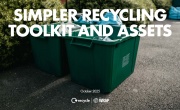Deposit return: A tried and tested solution for Scotland
As the momentum behind deposit return schemes in the UK grows, Clarissa Morawski, Managing Director at European circular economy platform Reloop, makes the case for their deployment in the fight against plastic waste and to increase recycled content in single-use beverage containers in the Scottish context
The Oxford English Dictionary defines ‘tried and tested’ as: ‘denoting something that has proven in the past to be effective or reliable’. Deposit return systems (DRS) are a tried and tested way of significantly increasing recycling rates while reducing plastic pollution and marine litter, which likely explains why support for such schemes has been gaining momentum all over the world as a solution to the problems caused by single-use beverage packaging.
Over the last 25 years, the world has witnessed an exponential growth in the consumption of single-use drinks containers. During this same period, there has been a coordinated and concerted effort by the producers of these products to persuade policy-makers to invest all of our time and money into municipal household recycling programmes and away from separately-implemented DRS.
Scotland has been at the forefront of the push to introduce a DRS in the UK, with Zero Waste Scotland (ZWS) launching a call for evidence on how a DRS could work in Scotland back in 2015, and Scottish First Minister Nicola Sturgeon committing the Scottish Government to introducing such a scheme across Scotland in September of last year, some time before UK Environment Secretary Michael Gove’s decision to do the same in England. While the exact design of a Scottish DRS still needs to be defined, there are a number of ways in which such a scheme will lead to better environmental outcomes for Scotland.
Missed the mark
One glance at recycling rates reveals that the current waste strategy has missed the mark and Scotland is not the only country to recognise that. Irrespective of how successful household recycling programmes are, beverage container recycling rates will continue to stagnate and litter will persist. The fact that more people are now living in multi-residential dwellings, coupled with the away-from-home consumption trend and relatively cheap and easy disposal, means recycling for drinks containers has achieved only moderate gains. It has also limited the amount of recycled content going back into plastic bottles, due to the challenge of obtaining enough high-quality recycled materials. In fact, a recent survey by Greenpeace found that the top six soft drinks companies in the world (excluding Coca Cola, who would not disclose their figures) use a combined average of only 6.6 per cent recycled PET globally.
Reliable benefits
DRS has evolved and innovated to the point where it is cost-effective, high performing and good for local jobs. With collection and recycling rates reaching upwards of 90 per cent, the clean material generated by deposit systems will create new business opportunities for Scotland in the form of markets for new collection and logistics services. It also has potential to create new jobs in processing, sorting and recycling.
DRS can also drive increased investment in domestic recycling capacity – a particularly important factor for local brand owners wanting to secure recycled feedstock. In the last few months alone several large brands, including Coca-Cola, Danone and Nestle, have committed to adopt ambitious recycled content goals.
In many ways, DRS in Scotland is about helping producers gain greater control over performance and costs by setting up a system that allows them to get their packaging back into the circular economy.
Effective DRS
Modern DRS models, such as those in Norway, Sweden, Finland, Estonia, Germany Lithuania, Oregon (USA), British Columbia (Canada), and Alberta (Canada), are run by industry and feature innovative technology that allows for efficient and convenient collection. These systems do not compete with municipal household recycling programmes, which are increasingly financed in part by brandowners of non-beverage packaging. Rather, they complement each other and save municipalities money through reduced collection, processing, disposal and litter costs. They also allow municipalities to focus their collection efforts on other items like food waste and recyclables generated at home.
What about retailers?
Opponents of DRS have cited the negative impact on retailers, who have to provide space and manpower to process deposit redemptions and store returned containers. The tides they a-changing, however, and support is growing from the retail sector to set up mandatory deposit return schemes to increase recycling and tackle marine pollution.
For example, in late 2017, UK retailers Co-Op, Iceland, Tesco, Lidl, Waitrose and Marks & Spencer all indicated that they would be open to introducing a deposit system for plastic bottles and have urged other retailers to follow suit.
Retailers can earn new sources of revenue through a handling fee paid for each container returned, or by simply leasing out some space for a third party operator. A number of studies have also found that when retailers provide a convenient return location for used containers, they benefit from increased sales and consumer footfall– as well as a valuable additional way to communicate with their customers.
And finally…
A few weeks ago the European Commission tabled the Single-Use Plastics Directive, which outlines a target of 90 per cent collection of beverage packaging by 2025. While the Directive still requires agreement from the EU Parliament and Council in the next few months, given that DRS is ‘tried and tested’ and proven in the past to be reliable at achieving 90 per cent collection, we should expect the Directive to pass. Scotland will lead the way to the top – well before England, France, Italy and Spain.










